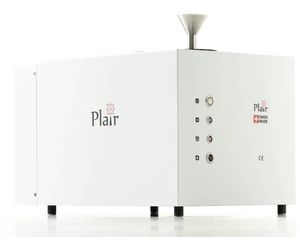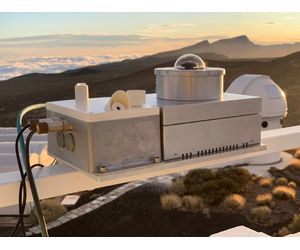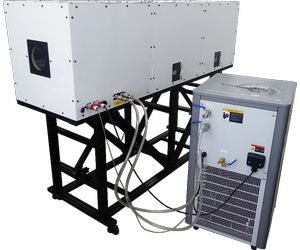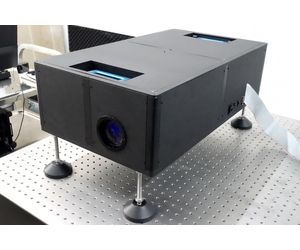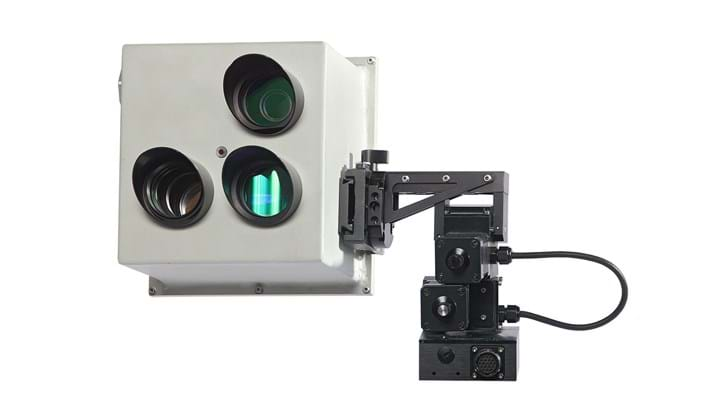
Rapid-E+ 是一种智能生物气溶胶传感器,利用获得专利的专有激光技术实时分析单个气溶胶颗粒。广受欢迎的 Rapid-E 仪器的更新版本改进了光学测量,可更有效地采样。其新开发的空气采样头提供了更大的空气流量,损失更小,性能优于所有现有的替代产品。

Plair智能实时生物气溶胶传感Rapid-E+
具有最高效的激光分析和嵌入式智能的实时空气颗粒识别器
Rapid-E+ 是一种智能生物气溶胶传感器,利用获得专利的专有激光技术实时分析单个气溶胶颗粒。广受欢迎的 Rapid-E 仪器的更新版本改进了光学测量,可更有效地采样。其新开发的空气采样头提供了更大的空气流量,损失更小,性能优于所有现有的替代产品。
Rapid-E+ 也是唯一通过 GPU(图形处理单元)加速实现集成智能的仪器。它能更快地采集和处理数据,为复杂环境中的气溶胶跟踪和识别带来革命性的性能。
所有的人工智能都可以通过网络或者来日内瓦进行培训。客户可以使用数据分析工具进行实时在线分析。数据分析工具由 Plair 提供,包含在软件包中。
Rapid-E+ 可以连续测量和表征 0.3 到 100 微米范围内的任何空气传播颗粒,包括细菌、真菌孢子、病毒、花粉和其他气溶胶。Plair 的技术基于散射光模式分析和荧光光谱学的独特组合,经过多年连续测量验证,可使研究人员可靠地实时监测环境空气。Rapid-E+ 可以自主和远程操作,并随时随地访问数据。
应用
- 花粉实时计数
- 颗粒物监测
- 细菌和真菌孢子检测
- 病毒气溶胶研究
Plair智能实时生物气溶胶传感Rapid-E+设计用于室内和室外使用
可用配件:室外机箱
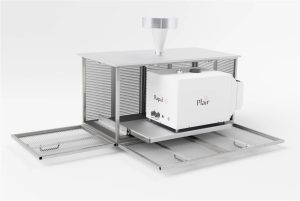
- 1. Branko Šikoparija, Predrag Matavulj, Gordan Mimić, Matt Smith, Łukasz Grewling, Zorica Podraščanin, Real-time automatic detection of starch particles in ambient air, Agricultural and Forest Meteorology, Volume 323, 2022, 109034, ISSN 0168-1923.
- 2. M. Smith, P. Matavulj, G. Mimić, et al.: Why should we care about high temporal resolution monitoring of bioaerosols in ambient air?, Science of the Total Environment (2021).
- 3. Forde,E et al.: Intercomparison of Multiple UV-LIF Spectrometers Using the Aerosol Challenge Simulator Aerobiologia, 2021.
- 4. Mimić, G,. et al.: Analysis of airborne pollen time series originating from Hirst-type volumetric samplers—comparison beTWeen mobile sampling head oriented toward wind direction and fixed sampling head with two-layered inlet Aerobiologia (Vol. 37, Issue 2, pp. 321–331), 2021.
- 5. Tumonn, F, et al.: A first evaluation of multiple automatic pollen monitors run in parallel (Vol. 197, p. 111109). Elsevier BV., 2021.
- 6. Suanno, C, et al.: Monitoring techniques for pollen allergy risk assessment (Vol. 197, p. 111109). Elsevier BV., 2021.
- 7. Swanson, B. E. et al.: Pollen clustering strategies using a newly developed single-particle fluorescence spectrometer Aerosol Science and Technology (Vol. 54, Issue 4, pp. 426–445),Informa UK Limited, 2020.
- 8. Kabir, E. et al.: Recent advances in monitoring, sampling, and sensing techniques for bioaerosols in the atmosphere ACS sensors, 5(5), 1254-1267, 2020.
- 9. Clot, B., et al.: The EUMETNET AutoPollen programme: establishing a prototype automatic pollen monitoring network in Europe Aerobiologia (2020): 1263-1274.
- 10. Maya-Manzano, J. M., et al.: Recent developments in monitoring and modelling airborne pollen, a review Grana (Vol. 60, Issue 1, pp. 1–19), 2020.
- 11. Branko Šikoparija: Desert dust has a notable impact on aerobiological measurements in Europe Aeolian Research, Volume 47, December 2020.
- 12. Danijela Tešendić et al.: RealForAll: real-time system for automatic detection of airborne pollen Enterprise Information Systems, 2020.
- 13. Sofiev, M. On possibilities of assimilation of near-real-time pollen data by atmospheric composition models Aerobiologia (Vol. 35, Issue 3, pp. 523–531), 2019.
- 14. Perspectives for nationwide pollen monitoring in Germany Perspektiven für ein bundesweites Pollenmonitoring in Deutschland. Bundesgesundheitsblatt – Gesundheitsforschung – Gesundheitsschutz (Vol. 62, Issue 5, pp. 652–661). Springer Science and Business Media LLC., 2019.
- 15. Huffman, J, et al.: Real-time sensing of bioaerosols: Review and current perspectives Aerosol Science and Technology (Vol. 54, Issue 5, pp. 465–495), 2019.
- 16. Fernández, Francisco Moya: Sistemas automáticos para la detección y análisis de bioaerosoles Revista de Salud Ambiental 19 (2019): 130-132.
- 17. Kawashima, S. et al.: Automated pollen monitoring system using laser optics for observing seasonal changes in the concentration of total airborne pollen Aerobiologia volume 33, pages 351–362(2017).
- 18. Ingrida Sauliene et al.: Automatic pollen recognition with the Rapid-E particle counter:the first-level procedure, experience and next steps Atmos. Meas. Tech., 12, 3435–3452, 2019.
- 19. Oteros, Jose, et al.: Building an automatic pollen monitoring network (ePIN): Selection of optimal sites by clustering pollen stations Science of the total environment 688 (2019): 1263-1274.
- 20. Buters, J, et al.: Allergene pollen in Nederland
- 21. Buters, J, et al.: Pollen and spore monitoring in the world Clinical and Translational Allergy (Vol. 8, Issue 1), 2018.
- 22. Kawashima, S. et al.: Automated pollen monitoring system using laser optics for observing seasonal changes in the concentration of total airborne pollen Aerobiologia volume 33, pages 351–362(2017).
- 23. Sindt, C. et al.: Alternative method for the measure of the biological particles in the air: RAPID-E example EAACI 2018.
- 24. Chappuis, C. et al.: Automatic pollen monitoring: first insights from hourly data Aerobiologia 36, 159–170 (2020)
- 25. Crouzy, B. et al.: All-optical automatic pollen identification: Towards an operational system Atmospheric Environment, Volume 140, September 2016, Pages 202–212.
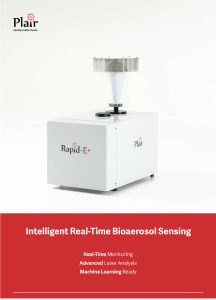
E-CATCH 空气颗粒物采样装置
E-Catch
E-Catch,即空气颗粒物采样装置,是专门为与 Rapid-E+ 结合使用而设计的,以提供更传统的基于实验室的空气颗粒物分析。经过 Rapid-E+ 分析的空气也可以由该装置按需采样。

使用 E-Catch 自动采样
E-Catch 包含 10 个可重复使用的采样板,可以独立地引入到 Rapid-E+ 的内部气流中,在任何时候、在任何时长内收集生物气溶胶。采样板可以进一步分析,并在稍后的阶段进行更换。
E-CATCH 空气颗粒物采样装置功能
1. 便于使用
2. 维护成本低
3. 同时可容纳十块采样板
4. 特别适用于 Plair Rapid-E+
5. 采样率可完全定制
参数
1.尺寸(长 x 宽 x 高):45 厘米 x 39 厘米 x 13 厘米
2.空气流速:每分钟 5 升
3.低功耗


